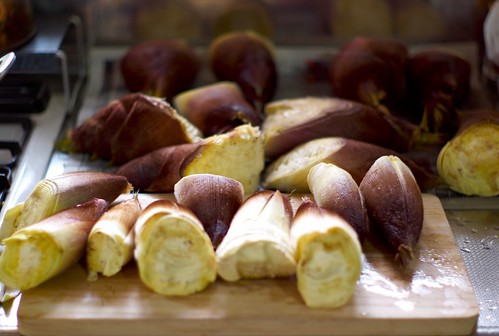 Foodbuzz.com graciously arranged for me to do a little tasting of Cowgirl chocolate truffles. I did an unboxing and a quick tasting, and here are the results for your pleasure.
Foodbuzz.com graciously arranged for me to do a little tasting of Cowgirl chocolate truffles. I did an unboxing and a quick tasting, and here are the results for your pleasure.What I Got In the mail, I got a Cowgirl Signature 1/4 Pound Truffle Box, which costs $12.95 for 8 individually, mylar-wrapped flavored chocolate truffles and one caramel in a heftily built gift box.
 What's Inside As you can sorta see from the pics, it's a nice looking gift with lots of decorative stuff on it. There's a sticker, tissue, a ribbon, a tag, and a western-themed, and a silver plastic star button (that unfortnately will go straight from the box into the landfill).
What's Inside As you can sorta see from the pics, it's a nice looking gift with lots of decorative stuff on it. There's a sticker, tissue, a ribbon, a tag, and a western-themed, and a silver plastic star button (that unfortnately will go straight from the box into the landfill).When you open the western-themed gift, what you get is handful of mylar wrapped truffles. Each tuffle is color coded, and there's a variety of flavored truffles to discover, everything from Ivory Orange to Habanero Dark Chocolate flavors in the box.
 Gift Impact
Gift ImpactI'm a big fan of simplicity, and I avoid buying anything with over-built, themed wrappings, trinkets and decorations all over it. The decade of the Hummer and Escalade is over. Even in gift giving, I like to follow a path of thoughtful simplicity.
Especially in these times when we're thinking a bit greener, I appreciate innovative ways to cut back on packaging rather than ways to bulk it up. Don't get me wrong, nothing was
 cheezy about the Cowgirl packaging (except the silver button), but IMHO there was just too darn much of it.
cheezy about the Cowgirl packaging (except the silver button), but IMHO there was just too darn much of it.For example, I would rather have had the flavor guide stamped onto the inside of the box top with a plain old, low-rez rubber stamper than have another bit of paper to throw away. I would rather have had received the truffles all naked nested in recylced paper than individually wrapped with more plastic I can't re-use. The ribbon was totally cool, however, and I'm already re-using it as a cat toy.
The Chocolates Themselves
For the sake of full disclosure, I tend to be pretty much a purist when it comes to chocolate, but I also love chocolate and chili flavors together, so I was excited about the Dark Chocolate Habanero flavor. To be fair, I usually buy bars, and I gravitate to high cocoa levels and never crave milk chocolates (or worse, white chocolate...if I want to eat pure fat, I'd rather dip bread in olive oil or eat crispy duck skin than eat vanilla flavored, sweetened palm oil emulsions).
However, for the sake of a balanced tasting, I chose both the hottest, darkest truffle for my own personal pleasure, and the lightest, blandest one on behalf of those who enjoy a milder treat.
The Habanero
The ingredient list for all of the chocolates reads well indeed. There's nothing artificial there, just good, solid flavorings. The Habanero truffle itself was not very spicy hot, it was imbued with a pleasant warmth to accompany the bitter and sweet flavors of the dark chocolate. The heat component was a simple, one note shot of capsacin without a lot of chili character. The dark chocolate wasn't bad, either, but it also lacked noticeable character or depth.
 The Ivory Orange
The Ivory Orange For the lighter side, I chose the Ivory Orange tuffle. It had a soft, creamsicle style with lots of sweetness and orange essence floating around. Again, it was a solid truffle, but it was a pretty simple bite. Nothing much to savor, there. It was milk chocolate and white chocolate in a marbled presentation.
The Verdict
These gift boxes are made with earnest care, the wrappings are colorful, and the theme is all americana. The chocolate itself is tempered beautifully and makes that "expensive" impact that many people enjoy. If you know someone who likes themed gifts with visual appeal and a little story and theme to accompany, you'll love giving these treats.
If you're looking for something with a more sophisticated, leaner presentation and an emphasis on adventurous flavor and ingredients, you're better off with Pierre Marcolini or traditional, old-world styles like Teuscher.



















